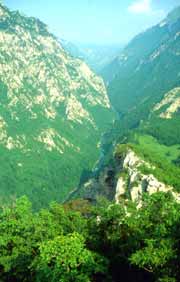
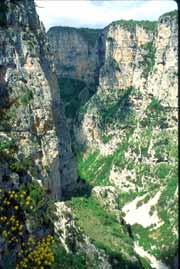
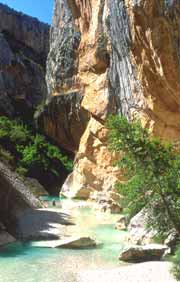
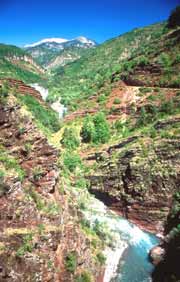
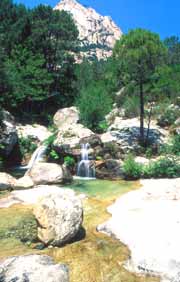
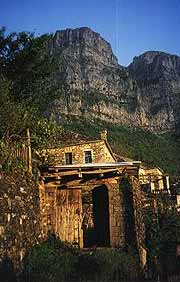
Canyonlands of Europe
Previous to 1995, I thought that Europe was too civilized a continent to accomplish any significant explorations or documentaries. Like all of the continents, however, canyoneering first got started in the 1980s on a serious level. Even today in 2004 there are perhaps some canyons in Europe that have yet to be documented.
It has been said that the Tara Canyon Yugoslavia was the deepest in Europe. In 1995, however, the most recent Balkans war was just beginning and promised to be a bloody, unpredictable, and savage ethnic conflict where American nature photographers might not be welcomed. At that point, I turned my attention to the Vicos Gorge in Greece which the Guinness Book of World Records said was the earth’s deepest canyon.
After completing my documentary of the Vicos Gorge and the River Styx in 1996, it was not until June 2001 that I returned to Europe to explore the canyonlands of Spain, France, and Corsica. The Spanish and French (and Bosnian) canyons share a limestone karst geological formation in common. This type of canyonlands is characterized by deep, narrow slot canyons interspersed by wider valleys. Wherever there is a karst outcrop or small mountain range it is very common to find highly eroded yet very narrow and technical slot canyons. This limestone geology, in fact, crosses most of southern Europe. Canyons can be found wherever these karst formations are occur which also includes southern Switzerland, northern Italy, as well as southern Austria. These are also wonderful areas for caves and indeed some of the canyons feature short underground sections.
Equally, the canyon cultures of Greece, Spain, France, Bosnia, and Corsica feature many similar characteristics. These areas have many small fortified towns built from limestone cobbles which, during various episodes of unrest, helped hide these little villages from raiders or invading armies. It was amazing how the style of these canyon hamlets closely resembled each other no matter what part of the Mediterranean or country in which you might be. There were even some cases where cliff houses, chapels, and monasteries resemble the Anasazi cliff dwellings of the American Southwest.
At the entryway of each canyon there was usually a fortified village and/or church designed so as to blend in to the surrounding cliffs. These camouflaged housing units or churches are often perched on a cliff, around the bend, and below the prow of a low hill wherever there is a dependable spring or water source. It would be possible in cases, if you did not know the location of the village, to pass within a few hundred yards of the town and not even know it was there. Each of these hamlets has a featureless exterior wall without windows that serves as the primary defensive mechanism. The visitor can pass through a few small gates and enter narrow, featureless streets for the first block. After that the village opens up with a plaza and church in the center of town.
Today these are lovely quaint mountain villas inhabited by mostly the elderly living a very quiet and tranquil lifestyle. There are often a few bed and breakfasts and small galleries available for the overnight visitors. In 2001 these quaint little villages were not overrun by tourism, but it could clearly be seen that they were extremely attractive to local tourists trying to get away from large cities such as Barcelona, Nice, or Athens.
Up in the canyons historic hideaways can be found where hermits once lived. It is easy to imagine that in times of war some of the local farmers or villagers could have used these as refuges. Some of these buildings were actually full fledged monasteries with a caretaker living there or in a nearby farmhouse.
In southern France, to the north and east of Nice is the spectacular Verdon Gorge. This is a magnificent limestone chasm that has some of the most challenging and dangerous canyoneering in all of Europe. This area is also one of the most beautiful and rugged yet civilized canyonlands of the planet. As France is famous for its wonderful food and wine, these remote gorges can be enjoyed to the fullest with first class canyoneering during the day and fine dining and bed and breakfast accommodations in the evenings. It is just great to pick up some fine French bread and cheese and a bottle of lusty red wine and spend a day hiking and swimming through emerald green pools surrounded by an evergreen forest offset by polished white limestone cliffs. One of the nicest things is that while this area of France is a very popular vacation destination, the depths of the canyons are often, for the most part, deserted.
The geology of the island of Corsica is granite which makes it unique in southern Europe. The island itself is reminiscent of California with white sandy beaches along the coast and a high sierra that occasionally gets snow in the interior. These isolated highlands of Corsica are not unlike Yosemite Valley of California. Beautiful emerald green pools are set in the polished white or coral granite. This area also features beautiful cypress trees like you might see at Monterey Bay, California. The island is very well watered and has lush vegetation throughout. Incised by hundreds of deep and rugged canyons, the pure waters of Corsica are the envy of the entire Mediterranean region.
The Balkans are characterized by karst canyonlands. In part, the ethnic diversity and strife that characterize the Balkans is a result of the corrugated canyonlands of deep slot canyons such as the Rakitnica and Tara canyons and the countless small valleys that naturally divide people into geographically isolated and historically hostile tribal groups.
There is a great debate in Europe as to the deepest canyon on the continent. To complicate the argument there are also some very deep and profound canyons in Turkey which may or may not be considered a part of Europe. The argument cuts strictly along nationalistic lines. From my viewpoint, Europe’s four deepest canyons run neck and neck for the top honors. The Vicos Gorge is recognized by the British and the Greeks, the Verdon is strictly defended by the French, and the Tara Canyon and the Rakitnica Canyon are debated, claimed, and defended by all three primary ethnic groups, the Croats, Serbs, and the Muslims. In my book they are all big winners and I would go back to visit any one of them or all of them in a heartbeat.
no frames - no navigation
Tibet | Africa | Paquime | Tepui | Australia | Mogollon Rim | Copper Canyon | Europe | Mars | Crystals